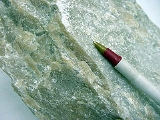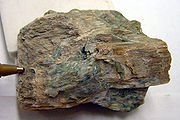
Brucite
Encyclopedia
Brucite is the mineral
form of magnesium hydroxide
, with the chemical formula Mg
(OH
)2. It is a common alteration product of periclase
in marble
; a low-temperature hydrothermal vein
mineral in metamorphosed limestone
s and chlorite
schist
s; and formed during serpentinization of dunite
s. Brucite is often found in association with serpentine, calcite
, aragonite
, dolomite
, magnesite
, hydromagnesite
, artinite
, talc
, and chrysotile
. Notable locations include Wood's Chrome Mine, Cedar Hill Quarry, Lancaster County, Pennsylvania
.
 Brucite was first described in 1824 and named for the discoverer, American mineralogist, Archibald Bruce (1777–1818). A fibrous variety of Brucite is called Nemalite. It occurs in fibers or laths, usually elongated along [1010], but sometimes [1120] crystalline directions
Brucite was first described in 1824 and named for the discoverer, American mineralogist, Archibald Bruce (1777–1818). A fibrous variety of Brucite is called Nemalite. It occurs in fibers or laths, usually elongated along [1010], but sometimes [1120] crystalline directions
.
and also constitutes a significant source of magnesium for industry.
or concrete
are exposed to non negligible concentration of Mg2+, e.g. when these materials are left in prolonged contact with sea water or brine
s, Mg(OH)2 precipitates under the high pH conditions prevailing in the cement porewater. The neoformation of brucite, an expansive material, induces mechanical stress in the hardened cement paste and is responsible for the formation of cracks
and fissure
s in concrete.
The use of dolomite
as aggregate
in concrete can also cause the magnesian attack and should be avoided.
Mineral
A mineral is a naturally occurring solid chemical substance formed through biogeochemical processes, having characteristic chemical composition, highly ordered atomic structure, and specific physical properties. By comparison, a rock is an aggregate of minerals and/or mineraloids and does not...
form of magnesium hydroxide
Magnesium hydroxide
Magnesium hydroxide is an inorganic compound with the chemical formula Mg2. As a suspension in water, it is often called milk of magnesia because of its milk-like appearance. The solid mineral form of magnesium hydroxide is known as brucite....
, with the chemical formula Mg
Magnesium
Magnesium is a chemical element with the symbol Mg, atomic number 12, and common oxidation number +2. It is an alkaline earth metal and the eighth most abundant element in the Earth's crust and ninth in the known universe as a whole...
(OH
Hydroxyl
A hydroxyl is a chemical group containing an oxygen atom covalently bonded with a hydrogen atom. In inorganic chemistry, the hydroxyl group is known as the hydroxide ion, and scientists and reference works generally use these different terms though they refer to the same chemical structure in...
)2. It is a common alteration product of periclase
Periclase
Periclase occurs naturally in contact metamorphic rocks and is a major component of most basic refractory bricks. It is a cubic form of magnesium oxide ....
in marble
Marble
Marble is a metamorphic rock composed of recrystallized carbonate minerals, most commonly calcite or dolomite.Geologists use the term "marble" to refer to metamorphosed limestone; however stonemasons use the term more broadly to encompass unmetamorphosed limestone.Marble is commonly used for...
; a low-temperature hydrothermal vein
Vein (geology)
In geology, a vein is a distinct sheetlike body of crystallized minerals within a rock. Veins form when mineral constituents carried by an aqueous solution within the rock mass are deposited through precipitation...
mineral in metamorphosed limestone
Limestone
Limestone is a sedimentary rock composed largely of the minerals calcite and aragonite, which are different crystal forms of calcium carbonate . Many limestones are composed from skeletal fragments of marine organisms such as coral or foraminifera....
s and chlorite
Chlorite group
The chlorites are a group of phyllosilicate minerals. Chlorites can be described by the following four endmembers based on their chemistry via substitution of the following four elements in the silicate lattice; Mg, Fe, Ni, and Mn....
schist
Schist
The schists constitute a group of medium-grade metamorphic rocks, chiefly notable for the preponderance of lamellar minerals such as micas, chlorite, talc, hornblende, graphite, and others. Quartz often occurs in drawn-out grains to such an extent that a particular form called quartz schist is...
s; and formed during serpentinization of dunite
Dunite
Dunite is an igneous, plutonic rock, of ultramafic composition, with coarse-grained or phaneritic texture. The mineral assemblage is greater than 90% olivine, with minor amounts of other minerals such as pyroxene, chromite and pyrope. Dunite is the olivine-rich end-member of the peridotite group...
s. Brucite is often found in association with serpentine, calcite
Calcite
Calcite is a carbonate mineral and the most stable polymorph of calcium carbonate . The other polymorphs are the minerals aragonite and vaterite. Aragonite will change to calcite at 380-470°C, and vaterite is even less stable.-Properties:...
, aragonite
Aragonite
Aragonite is a carbonate mineral, one of the two common, naturally occurring, crystal forms of calcium carbonate, CaCO3...
, dolomite
Dolomite
Dolomite is a carbonate mineral composed of calcium magnesium carbonate CaMg2. The term is also used to describe the sedimentary carbonate rock dolostone....
, magnesite
Magnesite
Magnesite is magnesium carbonate, MgCO3. Iron substitutes for magnesium with a complete solution series with siderite, FeCO3. Calcium, manganese, cobalt, and nickel may also occur in small amounts...
, hydromagnesite
Hydromagnesite
Hydromagnesite is a hydrated magnesium carbonate mineral with the formula: Mg542.4H2O.It generally occurs associated with the weathering products of magnesium containing minerals such as serpentine or brucite. It occurs as incrustations and vein or fracture fillings in ultramafic rocks and...
, artinite
Artinite
Artinite is a hydrated magnesium carbonate mineral with formula: Mg22·3H2O. It forms white silky monoclinic prismatic crystals that are often in radial arrays or encrustations. It has a Mohs hardness of 2.5 and a specific gravity of 2....
, talc
Talc
Talc is a mineral composed of hydrated magnesium silicate with the chemical formula H2Mg34 or Mg3Si4O102. In loose form, it is the widely-used substance known as talcum powder. It occurs as foliated to fibrous masses, its crystals being so rare as to be almost unknown...
, and chrysotile
Chrysotile
Chrysotile or white asbestos is the most commonly encountered form of asbestos, accounting for approximately 95% of the asbestos in place in the United States and a similar proportion in other countries. It is a soft, fibrous silicate mineral in the serpentine group of phyllosilicates; as such, it...
. Notable locations include Wood's Chrome Mine, Cedar Hill Quarry, Lancaster County, Pennsylvania
Lancaster County, Pennsylvania
Lancaster County, known as the Garden Spot of America or Pennsylvania Dutch Country, is a county located in the southeastern part of the Commonwealth of Pennsylvania, in the United States. As of 2010 the population was 519,445. Lancaster County forms the Lancaster Metropolitan Statistical Area, the...
.
Discovery

Miller index
Miller indices form a notation system in crystallography for planes and directions in crystal lattices.In particular, a family of lattice planes is determined by three integers h, k, and ℓ, the Miller indices. They are written , and each index denotes a plane orthogonal to a direction in the...
.
Industrial applications
Brucite is used as a flame retardantFlame retardant
Flame retardants are chemicals used in thermoplastics, thermosets, textiles and coatings that inhibit or resist the spread of fire. These can be separated into several different classes of chemicals:...
and also constitutes a significant source of magnesium for industry.
Magnesian attack of cement and concrete
When cementCement
In the most general sense of the word, a cement is a binder, a substance that sets and hardens independently, and can bind other materials together. The word "cement" traces to the Romans, who used the term opus caementicium to describe masonry resembling modern concrete that was made from crushed...
or concrete
Concrete
Concrete is a composite construction material, composed of cement and other cementitious materials such as fly ash and slag cement, aggregate , water and chemical admixtures.The word concrete comes from the Latin word...
are exposed to non negligible concentration of Mg2+, e.g. when these materials are left in prolonged contact with sea water or brine
Brine
Brine is water, saturated or nearly saturated with salt .Brine is used to preserve vegetables, fruit, fish, and meat, in a process known as brining . Brine is also commonly used to age Halloumi and Feta cheeses, or for pickling foodstuffs, as a means of preserving them...
s, Mg(OH)2 precipitates under the high pH conditions prevailing in the cement porewater. The neoformation of brucite, an expansive material, induces mechanical stress in the hardened cement paste and is responsible for the formation of cracks
Fracture
A fracture is the separation of an object or material into two, or more, pieces under the action of stress.The word fracture is often applied to bones of living creatures , or to crystals or crystalline materials, such as gemstones or metal...
and fissure
Fissure
In anatomy, a fissure is a groove, natural division, deep furrow, elongated cleft, or tear in various parts of the body.-Brain:...
s in concrete.
The use of dolomite
Dolomite
Dolomite is a carbonate mineral composed of calcium magnesium carbonate CaMg2. The term is also used to describe the sedimentary carbonate rock dolostone....
as aggregate
Construction Aggregate
Construction aggregate, or simply "aggregate", is a broad category of coarse particulate material used in construction, including sand, gravel, crushed stone, slag, recycled concrete and geosynthetic aggregates. Aggregates are the most mined material in the world...
in concrete can also cause the magnesian attack and should be avoided.
See also
- List of minerals
- List of minerals named after people
- CementCementIn the most general sense of the word, a cement is a binder, a substance that sets and hardens independently, and can bind other materials together. The word "cement" traces to the Romans, who used the term opus caementicium to describe masonry resembling modern concrete that was made from crushed...
- ConcreteConcreteConcrete is a composite construction material, composed of cement and other cementitious materials such as fly ash and slag cement, aggregate , water and chemical admixtures.The word concrete comes from the Latin word...
- PortlanditePortlanditePortlandite is a rare oxide mineral, the naturally occurring form of calcium hydroxide . It is the calcium analogue of brucite .-Occurrence:...
, Ca(OH)2

